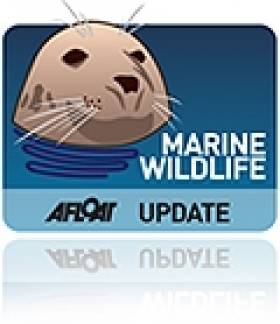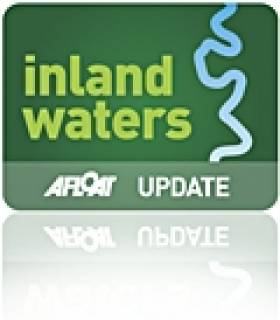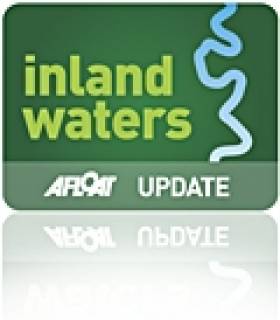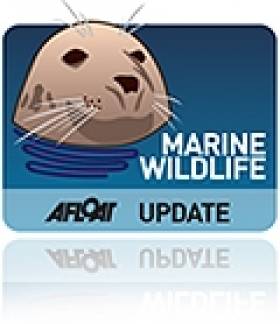Displaying items by tag: Northern Ireland Environment Agency
Environment Award for NI Angling Club
#INLAND WATERWAYS - The Tyrone Times reports that Clogher and District Angling Club has been awarded £1,000 (€1,196) by the Northern Ireland Environment Agency (NIEA) for an environmental project with local schools.
The Water Environment Community Awards recognised the club for its work with St McCartan's Primary School in Clogher and Augher Central Primary School to "investigate the signs and impact of pollution in the River Blackwater" over the coming months.
“Clogher and District Angling Club have demonstrated their commitment to protecting and improving their local water environment," said the NIEA's Dave Foster.
"I hope that their efforts over the next few months will inspire others to do their bit too and I would urge people to follow these projects and share what they see.”
'Rogue' Anglers May Shoot Seals Threatening NI Fish Stocks
#MARINE WILDLIFE - Northern Ireland's Green Party has warned that "rogue" anglers may shoot seals that are consuming their fish stocks unless they are relocated, the Belfast Telegraph reports.
The protected seals have been getting into the River Quoile in Co Down, allegedly by way of a damaged fish pass, and decimating the area's fish stocks - much to the consternation of local anglers.
Earlier this week Leisure Minister Carál Ní Chuilín confirmed in a response to a question from Green Party MLA Steven Agnew that department officials have requested the Rivers Agency to carry out repairs on the fish pass.
But she also said that no action can be taken to remove seals from the river "without the approval of the Northern Ireland Environment Agency", adding that her department "does not have the specialist knowledge and equipment to remove the seals".
A Green Party spokesperson described the repair work as "absolutely vital because even if the seals are safely removed from the Quoile they will only make their way back in if the fish pass is not repaired.
"And a rather worrying consideration is that a very small rogue element would be prepared to shoot the seals if a solution is not forthcoming.”
Seal shootings have been much in the news as of late, with gardaí in Waterford investigating attacks on four animals in Tramore.
NI Officials Investigate Fish Kill in Newtownabbey
#INLAND WATERWAYS - Officials at the Northern Ireland Environment Agency (NIEA) are attempting to find the source of a pollutant that resulted in a fish kill on the Threemilewater river in recent weeks.
The Newtownabbey Times reports that more than 120 trout and salmon parr have been found dead on the short stretch of river between Mossley Mill and Doagh Road in Newtownabbey, Co Antrim.
John Webster of the Threemilewater Conservation and Angling Association speculated that the pollutant may have entered the water from any of a number of pipes that flow into the waterway near the railway line at Mossley Mill.
He described the fish kill as "an absolute diasaster", especially coming as it did at the opening of the fishing season on 1 March.
The Newtownabbey Times has more on the story HERE.
Atlantic Salmon on 'Red List' of Endangered Species
Atlantic salmon have joined four other native fish on a 'red list' of endangered species compiled by the Ireland's fisheries and wildlife agencies.
As the Irish Independent reports, one third of the State's 15 native fish species are considered endangered or vulnerable.
One of the worst hit is the European eel, which was found to be critically endangered.
In a report published yesterday, a number of threats were highlighted such as water pollution, invasive species, overfishing, poor river management and climate change.
According to The Irish Times, the Red List was compiled by scientists from organisations across the island including Inland Fisheries Ireland, the National Parks and Wildlife Service, the Northern Ireland Environment Agency and the National Biodiversity Data Centre.
The news comes just a few days after Dublin celebrated the return of wild Atlantic salmon to the River Tolka after more than a century.
The Irish Times has more on the story HERE.
Inter-Agency Response to Lough Erne Weed Invasion
A new inland waterways inter-agency response to the rising levels of invasive weed growth on Lough Erne has been launched.
The Lough Erne Invasive Species Group (LEISG) brings together Fermanagh District Council, the Northern Ireland Environment Agency (NIEA), Waterways Ireland, the UK's Departments of Culture, Arts and Leisure, and Agriculture and Rural Development, among others, to tackle the threat posed by the invasive Nuttall's Pondweed.
LEISG says the weed has survived the winter "in significant quantities", and the potential for its rapid spread poses a serious concern for tourism and leisure on Co Fermanagh.
The group has recommended harvesting and weed-cutting as the most effective method to control Nuttall's Pondweed where it may interfere with main channels and access to public amenities.
Management of water levels has also been identified as playing a role in future control of the weed.
Anyone wishing to assist in weed-cutting must contract the NIEA through www.nidirect.gov.uk for permission. More information on invasive species is available at www.invasivespeciesireland.com.
Strangford Seal Deaths (Warning Picture May Upset Some Viewers)
The Northern Ireland Environment Agency (NIEA) has expressed concerns over a high number of unnatural seal deaths reported in recent years along the County Down coast.
Declan Looney, Senior Wildlife Inspector with the NIEA said: "Both harbour and grey seals are species protected under European and Northern Ireland legislation. Between late June and the end of November 2009, 16 seal carcasses were recovered from the shores of County Down, largely from Strangford Lough, Minerstown and Dundrum Bay.
"These were submitted for post mortem examination by veterinary pathologists. Twelve of them (predominantly grey seal pups and juveniles) showed signs of having suffered an unnatural death."
The post mortems undertaken in 2008 and 2009 found evidence of drowning, fractured jaws, and extensive knife cuts (generally around the neck) made following the animals' deaths. Several had the head cut off. Severe trauma consistent with gunshot wounds or blows from sharp objects was also recorded.
Though circumstantial evidence indicates interaction with some form of net in at least two cases, there is no proof that these seal deaths have resulted from legitimate, licensed fishing activity. Neither is there evidence linking these deaths to the marine current turbine being trialled in the Strangford Narrows, as this would not inflict the sharp cuts seen.
The Agency accepts that some deaths by drowning may be the result of inadvertent by-catch in legitimate fishing nets. The reporting of such instances will help evaluate the scale of this problem and assess ways of minimising this risk.
Declan Looney added: "The Agency is investigating the causes of this mortality and is liaising with other relevant organisations to address the issue. Members of the public can assist by reporting all dead seal strandings to NIEA on 028 4461 5520.
"Anyone who witnesses suspicious activity involving seals should report this immediately to their local PSNI station, telephone 08456 008 000 or call Crimestoppers anonymously on 0800 555 111.
"Any information on suspected illegal netting for sea trout and salmon should be reported on 0800 80 70 60."
Where live seal pups appear to have been abandoned, they should not be approached as their mothers are probably nearby. However where there is real concern over the welfare of such pups and they appear to be injured, sick or distressed, the circumstances should be reported to the Northern Ireland Aquarium (Exploris) on 028 4272 8062 or 028 4272 8002.

This photo was taken at Kircubbin on Strangford Lough, the stick in the picture is a metre rule which gives some perspective
Further Information:
1. Both the harbour (common) seal and grey seal are protected in Northern Ireland by inclusion on Schedule 5 of the Wildlife (NI) Order 1985 as 'animals which are protected at all times'. Both species are also listed on Schedule 6 as 'animals which may not be killed or taken by certain methods' and on Schedule 7 as 'animals which may not be sold alive or dead at any time'.
Anyone with evidence of killings of Schedule 5 species should report this to the PSNI. The PSNI has a Wildlife Liaison Officer who will work closely with the local police station in following up these sorts of cases with a view to prosecution.
2. Both the harbour seal and grey seal are also listed under Annex II of the EC Habitats Directive (1992) as species whose conservation requires the designation of Special Areas of Conservation (SAC). In Northern Ireland there are two SACs where common seals are qualifying features - Strangford Lough SAC and Murlough SAC. However, as species of Community interest (SCI) they are protected wherever they occur, within designated sites or outside.
3. Both species are listed on Annex V of the EC Habitats Directive (1992) as species of community interest whose taking in the wild and exploitation may be subject to management measures.
4. Seals are also protected, through the Environment (Northern Ireland) Order 2002, where listed as a feature within ASSIs. This is the principal site protection measure in Northern Ireland and has aspects of relevance for a diverse range of marine users, including the powers to prohibit or restrict entry into or movement within ASSIs of people, vehicles and boats. This order makes it an offence to intentionally or recklessly damage or destroy any feature of interest.
5. Harbour and grey seals are also listed on Schedule 3 of the Conservation (Natural Habitats, etc.) Regulations (NI) 1995, providing protection from indiscriminate methods of taking and killing. They are also included in Part IV which requires that appropriate assessments are undertaken for SACs which list seals as qualifying features.
6. The Northern Ireland legislation protecting seals is stronger than that for Great Britain. Here the only situation in which seal killing is legally permitted is where a seal is causing 'serious damage' to a fishery. Such killing must immediately be reported to NIEA with an explanation of the circumstances, which NIEA would expect to give evidence that all attempts to exclude or scare it away had failed.
7. Exceptionally NIEA has issued licenses to the operators of 'fixed engine' salmon nets and fish farm cages to kill seals in response to immediate serious threat to these fisheries, again to be used as a last resort and to be reported to NIEA.
8. Since the 2002 outbreak of the Phocine Distemper Virus (PDV), NIEA has maintained a record of all seal mortalities. As a result of the enhanced environmental monitoring associated with the trial Marine Current Turbine in the Strangford Narrows, all seal carcasses found between Cloghy and Minerstown, including all of Strangford Lough, are now recovered for post mortem examination, except where already in an advanced state of decay.
9. 2008 Seal Mortalities
The 2008 post mortem reports revealed:
• Of the 18 seal carcasses which were submitted for post mortem examination, 9 seals showed evidence indicative of an unnatural death
• 4 seals had the head removed by a sharp blade (not through decomposition as happens naturally)
• 1 seal had net caught around its neck.
• All the unnatural mortalities were recorded between 12th September and 10th November.
2009 Seal Mortalities
The 2009 post mortem reports revealed:
• Of the 16 seal carcasses submitted for post mortem examination, 10 were grey seals (7 pups, 3 adults), 2 were common seals (1 pup, 1 adult) and 4 seals were of indeterminable/unrecorded species (due to advanced autolysis).
• 12 carcases had evidence indicative of knife cuts, drowning, shot wounds or broken jaw. Several seal carcases displayed evidence of a combination of injuries as follows:
• Knife cuts (n=9)
• Drowning (n=5)
• Shot wounds (n=2)
• Jaw fractures (n=1)
• All unnatural mortalities were recorded between 25th June and 30th November.
10 More information on the seals of County Down can be found on the Strangford Lough and Lecale Partnership website www.strangfordlough.org



































































